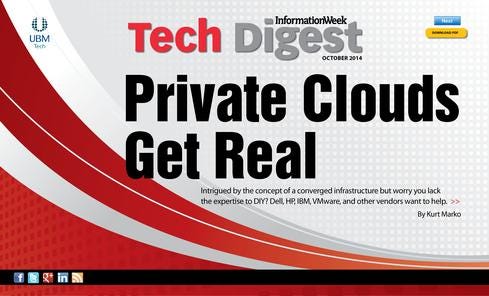Private Clouds Come Down To EarthPrivate Clouds Come Down To Earth
Intrigued by the concept of a converged infrastructure but worry you lack the expertise to DIY? Dell, HP, IBM, VMware, and other vendors want to help.

 Download the latest issue of information Tech Digest, distributed in an all-digital format (registration required).
Download the latest issue of information Tech Digest, distributed in an all-digital format (registration required).
Plenty of CIOs like the idea of a converged data center but get headaches thinking about the complexity. Even given wide support for open standards, stitching discrete server and storage systems into a software-abstracted cloud is not for the faint of heart. Enter preassembled private cloud stacks, such as Dell's PowerEdge C-series, Hewlett-Packard's ProLiant SL Scalable Systems, and IBM's NeXtScale System. VMware, Nutanix, and a slew of specialized vendors are also in this hunt. These systems can cost-effectively deliver scale-out cloud functionality, high density, and manageability without significant compromise on features.
That's good news for the majority of respondents to our 2014 information Hybrid Cloud Survey who have private cloud plans but, for one reason or another, have not yet put those strategies into production. Among 383 business technology professionals taking part in that survey, 28% have built private clouds, and 20% have no plans. The remaining 52% are piloting, planning to deploy within a year, or thinking about it.
The will is there. It's the execution that's problematic for many.
One reason is that there is no standard blueprint for building a next-generation software-defined infrastructure. The term "private cloud" describes everything from automated virtual machine system administration to fully orchestrated and self-service compute, storage, and network resources that end users and developers can provision themselves. Given this uncertainty and complexity, the pioneers tend to be businesses that began on public cloud infrastructure and are comfortable living on the bleeding edge of technology.
For enterprise IT, private clouds typically take shape one of two ways: We enhance existing virtual server farms, or build separate, greenfield private clouds and then try to figure out how to extend them. Remodeling production systems can take you only so far, and it's fraught with risk to existing services. Building a separate private cloud from the ground up is a great exercise in design theory. It's also a great way to end up in an integration nightmare. These are the pain points converged products, including VMware's new EVO:RAIL platform and appliances for remote sites designed to tether to centralized systems, seek to ease.
Problem statement
The appeal of clouds -- public or private -- is that you get a model where everything from compute cycles and storage to fully packaged applications are logically decoupled from the infrastructure used to provide them. To use a popular metaphor, private clouds turn enterprise infrastructure elements from pets into cattle -- from things you lovingly tend into nameless herds of abstract IT resources with a limited life expectancy. The dramatic growth of Amazon Web Services, Microsoft Azure, and Google's Cloud Platform illustrates the appeal.
But not every business, application, or data set is a good fit for shared infrastructure, and enterprise CIOs are rightly wary of completely entrusting the critical underpinnings of their businesses to third-party vendors and an infrastructure paradigm still exhibiting growing pains. They want the advantages of AWS, but operated on their own terms. Enter the private cloud.
A note to that 20% or so with no interest: You might be chagrined to learn that US federal CIOs are taking the Obama administration's "Cloud First" mandate to heart by consolidating infrastructure, building private clouds, and incorporating commercial infrastructure-as-a-service into a hybrid architecture. The latest information Federal Government IT Priorities Survey finds 39% of respondents had consolidated one or more data centers, with an additional 23% planning on it, while more than half are implementing some form of private, public, or hybrid cloud
To read the rest of this story,
download the October issue of information Tech Digest.
About the Author
You May Also Like






